#New Zealand wildlife park
Text
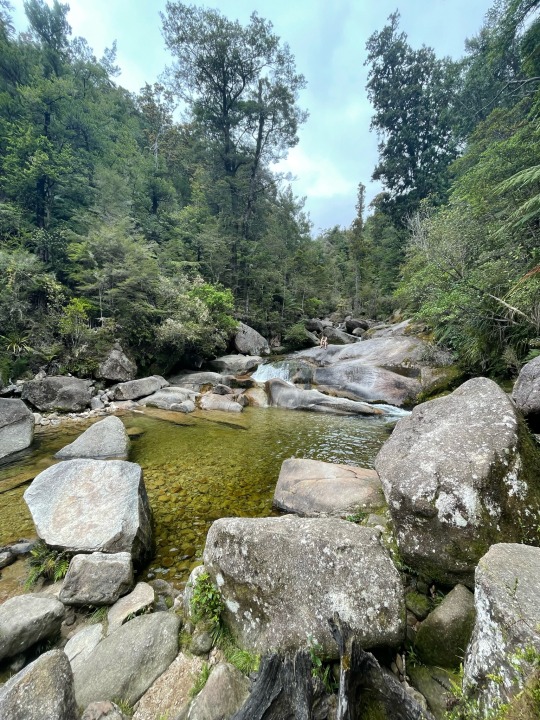
Cleopatra pools, Able Tasman National park
#nature#forest#new zealand#new zeland landscape#travel#camping#nature asthetic#wilderness#film#green#hiking#vintage#wildlife#national park#river
57 notes
·
View notes
Text
The Best News of Last Week - May 15, 2023
🧲 - Magnetic Marvels: Researchers Flip the Switch on Depression
1. New Zealand Government announces prescriptions charges will be free.

The $5 prescription fee at pharmacies will be scrapped in July. This is set to save about 3 million people a year money, and in particular 770,000 people aged over 65. It will make most prescriptions in New Zealand free.
Free access to medicines is also hoped to ease pressure on the over-burdened health system by helping people get medicines sooner.
2. Platypuses return to Sydney's Royal National Park after disappearing for decades

Platypuses have been relocated to the Royal National Park in Sydney, after they disappeared from the park's waterways about 50 years ago. A joint project by the University of New South Wales, NSW National Parks and Wildlife Service and the World Wildlife Fund has reintroduced five females to the Hacking River, with a group of males to follow next week.
3. 74-year-old musician Otis Taylor gets Denver high school diploma decades after being expelled for hair

A musician who was expelled from a Denver high school over 50 years ago received his diploma. Otis Taylor was kicked out of Manual High School in 1966 because of his hair. This was decades before laws ending racial hair discrimination. Denver Public Schools wanted to right a wrong.
4. Researchers treat depression by reversing brain signals traveling the wrong way (with magnets)

A new study led by Stanford Medicine researchers is the first to reveal how magnetic stimulation treats severe depression: by correcting the abnormal flow of brain signals. Powerful magnetic pulses applied to the scalp to stimulate the brain can bring fast relief to many severely depressed patients for whom standard treatments have failed.
The FDA-cleared treatment, known as Stanford neuromodulation therapy, incorporates advanced imaging technologies to guide stimulation with high-dose patterns of magnetic pulses that can modify brain activity related to major depression. Compared with traditional TMS, which requires daily sessions over several weeks or months, SNT works on an accelerated timeline of 10 sessions each day for just five days.
5. Electricity generation through solar, wind and water exceeded total demand in mainland Spain on Tuesday, a pattern that will be repeated more and more in the future

The Spanish power grid on Tuesday tasted an appetizer of the renewable energy banquet that is expected to flourish in the coming years. For nine hours, between 10 a.m. and 7 p.m., the generation of green electricity was more than enough to cover 100% of Spanish peninsular demand, a milestone that had already been reached on previous occasions, but not for such a prolonged period.
6. RI Senate passes bill making lunch free at all public schools

Free lunch for all public school students in Rhode Island is one step closer to becoming a reality.
Tuesday night the Rhode Island Senate overwhelmingly passed a bill by a vote of 31-4 that would do just that. If the companion bill in the House were to pass, that takes effect July 1. The bill would make breakfast and lunch free for all public school students in the state, regardless of their household income.
7. Critically endangered red wolf pups born at North Carolina Zoo
The North Carolina Zoo in Asheboro celebrated the arrival of “not one but TWO litters” of the world’s most endangered wolf – the red wolf – in late April and early May.
A total of nine pups were born – three to parents Marsh and Roan, and six to Denali and May – the zoo announced on May 9.
----
That's it for this week :)
This newsletter will always be free. If you liked this post you can support me with a small kofi donation:
Buy me a coffee ❤️
Also don’t forget to reblog.
SUBCRIBE HERE for more good news in your inbox
2K notes
·
View notes
Text



The Kunekune pig comes from New Zealand, thought to be a descendant of an Asian domestic bread introduced in the 19th century. Their name, pronounced Cooney Cooney, means fat and round in Maori.
In the 1980s the bread was facing extinction with only about 50 purebred left in New Zealand but as of 2010 no longer face extinction due to the conservation efforts of Michael Willis and John Simister, two wildlife-park owners. Kunekune are incredibly docile and friendly, making them not only good pigs to raise for their meat but as companion animals as well.
78 notes
·
View notes
Text
Gondwana was the great southern landmass that formed as a result of the division of a much larger supercontinent known as Pangea about 250 million years ago. This Gondwanan supercontinent consisted of present day landmasses: Africa, South America, India, Madagascar, Australia and New Zealand. The other section of Pangea, known as Laurasia, comprised what are now Europe, Asia and North America.
Gondwana, The great supercontinent, Parks and Wildlife Service Tasmania, Department of Environment, Parks, Heritage and the Arts
9 notes
·
View notes
Text
Personal: Assholes at the Lake
Apparently the crack down on illegal fireworks spirred by wildfire risk is working. Not only did we not get a week of random explosions, I couldn't hear professional explosions or neighborhood ones unless I went outside. No one set anything off in my complex let alone right uder the livingroom window as is the usual practice. As far as I could tell the cats didn't notice.
The sky has been subtly uncanny valley for… I'm guessing a weekish? Suntly the wrong colour. No clouds. Yes, in a lot of places no clouds is fine, but here, there are almost always clouds of some sort. Normal cloudless periods are like a couple hours at most. Day after day of no clouds at all is absolutely a climate change thing in our weird little micro-environment, it's only been happening for a few years and I associate it with wildfires. The sky isn't bruise or orange, so that's good, but now and then, I get a whiff of something burning that shouldn't be. I can't explain it, but the sky's the wrong shade of blue to the south. Without clouds, the sky is too big here.
It is very much not helping that I keep having to go out into the extreme heat and pollen, whether I want to or not and it's a problem. I have had heat exhaustion, and once, likely heat stroke, but wasn't given proper medical attention at the time. (I'm not writing about it again now; I am tired). I was never particularly good at high heat and humidity. I can't really function in it at all now. Add in all the pollen and i struggle to think and breath and move about.
The cats are stressed, of, course, but it's because they are worried about my health (I'm moving in ways that show obvious extreme pain and exhaustion) and because of two months of massive disruptions to their schedules and periodic human intruders including men with boots. These things are also freying at me, but I didn't piss all over the sofa, nor did I start a literal pissing contest with a cat in another part of town over which cat Goth Millenial belongs to. My having to deal with all the extra mess and laundry is not helping. I am looking very hard at you, Tavy.
My physio is going very badly. I keep having to pull chunks of excercise sets because my arm noipes out or standing hurts to much to do that many of the ones I can only do standing up.
I did take some of the Millenials out to the lake sunday. We tried to go to the one without invasive wildlife, but spent ages just to not get in. I drove back to my end of town. I always liked that lake better, but you have to decontaminate everything to avoid spreading the snails kayakers brought from new zealand. I didn't see any fish, and it looked like there were fewer dragonflies The trees and the water were still beautiful though. We swam until my arm gave out and we had cheese, crackers, and fresh lychee while watching families swim.
Then the assholes turned up. Aparently they had been there earlier, as they claimed that the crumpled up abandoned looking towel they'd casually dropped at the edge of the cut a body length away from us meant that we were encroaching on them somehow. It was a crowded day at the lake. Four feet would not have been a weird distance even if we hadn't thought it was just a lost towel or they'd had it spread out with gear like a normal person. We weren't blocking access. we had yto be close to the water because i'm an older disabled person and as it was the crawl from the water's edge was pergatorial. (I decided it would be easier and hurt less then them levering me up and me hobbling the distance. Did i mention my spine and hips are nightmares right now?)
So the assholes got angry at us for not intuiting that they owned a 15 yard stretch of close to the water space in a public park by virtue of them having dropped a balled up towel near it. O.o It was 6:30ish PM. You literally can't get a sunburn that late at this latitude, because the angles are wrong. They stood close and sprayed and sprayed and sprayed arisol sunblock all over each other which blillowed towards us in a cloud. And not just us, but a dad and a two and a half year old toddler. I nmentioned I was a lung patient, so she started blowing massive about of vape at us. And the dad. And the toddler with delicate lungs, because that's just how entitled they were to the entire strech of land between too batches of reeds and we all deserved chemical warfare for daring to do normal things at the lake. Which as douche bag white 20 somethings they owned. We all got sore throats and queasy, I was coughing and had lung and breathing trouble all night. The Millenials were angry they were doing this to an elder, especially one who had an assistive devise and was obviously disabled. I was angry that they did this to a baby playing along the thin stretch of beach with her dad watching over her.
I am pretty sure I am not the asshole here.
Bonus? We lost the housing increase battle and somehow I must find an extra $142 a month starting in august while still paying all the other bills and buying things I can't do without, like toilet paper. I am still catching up for the refridgerator. The Millenials are all going through a bunch of no fault of their own crises too and two of them need to move by the end of the month.
It is A LOT. Especially in this terrible unnatural heat. Which I now need to go out in again for arm torture. Sigh.
2 notes
·
View notes
Text
The Princess Royal visits New Zealand

Day One
The Princess Royal arrived at Government House in Wellington and was welcomed by the Governor General of New Zealand, Her Excellency the Rt. Hon. Dame Cindy Kiro.
Day Two
Her Royal Highness started the day by meeting the Prime Minister of New Zealand, Christopher Hipkins.
The Princess Royal subsequently visited the National Crisis Management Centre at the Executive Wing in Wellington to meet those involved in the response to Cyclone Gabrielle.
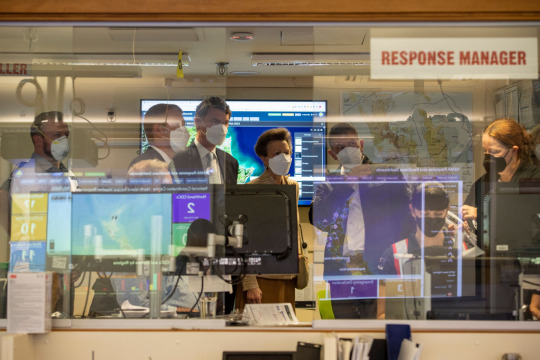
“You should all be proud of the resilience, strength and care for your communities you are showing in the face of adversity.
Kia Kaha”
Her Royal Highness also visited the Museum of New Zealand.

As Colonel-in-Chief of the Royal New Zealand Corps of Signals, Her Royal Highness attended a reception to mark the centenary of the Corps.

The day finished at the National War Memorial in Wellington, where The Princess attended a Service of Remembrance and laid a Wreath on the Tomb of the Unknown Warrior.
Day Three
Her Royal Highness visited the New Zealand Riding for the Disabled group in Porirua, and handed out rosettes to young riders and long-serving volunteers. The Princess joined Riding for the Disabled (RDA) as its Patron in 1971, later becoming President in 1985.

Next, Her Royal Highness opened the Mission to Seafarers new Wellington Mission, and later unveiled the foundation stone for the Mission to Seafarers and Merchant Navy Memorial at Wellington Cathedral.
The Princess is President of the charity, which provides support for the practical and spiritual welfare of seafarers of all nationalities and faiths.

Day Four
The Princess Royal started her fourth day in New Zealand at Tūranga Library in Christchurch, to hear about the rebuilding of Christchurch Central City and Christ Church Cathedral. Her Royal Highness also visited the site of Christ Church Cathedral in Cathedral Square.

Later, The Princess Royal attended the Rededication Service for the Citizens' War Memorial and laid a wreath in Cathedral Square.

As President of the Royal Agricultural Society of the Commonwealth, Her Royal Highness met representatives of the Royal Agricultural Society of New Zealand and Canterbury Agricultural and Pastoral Association at Canterbury Agricultural Park.
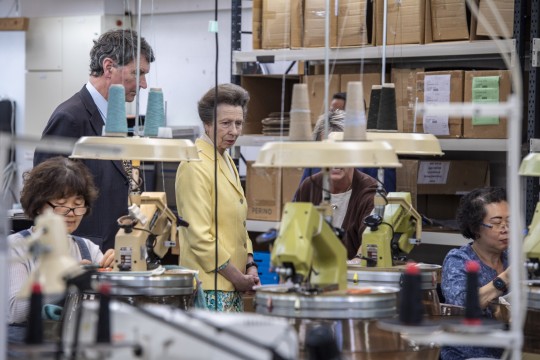
The Princess Royal later visited Untouched World Merino and Natural Fibre Workrooms.
Afterwards, Her Royal Highness visited Willowbank Wildlife Reserve. The Princess Royal is Patron of the New Zealand Conservation Trust.

© Royal UK
36 notes
·
View notes
Text
tumblr book report time
okay, I finished Last Chance to See by Douglas Adams earlier today! I did say in the post a few hours ago I only had about 40 pages left. I also reread about another 80 or so pages that I read last year just to refresh my memory. So, I'm now going to do the (potentially) depressing task of listing out the endangered species features in this book, and seeing if any are still alive. I don't know yet how depressing or exciting this post might be.

Madagascar
This part of the book is from a trip in 1985, where they went to try and find the aye-aye lemur. I am pleased to report that the aye-aye is still alive, although still endangered. Woo-hoo! The aye-aye is the world's largest nocturnal primate, and is so unique it has no taxomic family (no related species.) They are considered evil, or harbingers of death, in folk belief, so they face danger from being hunted and killed.
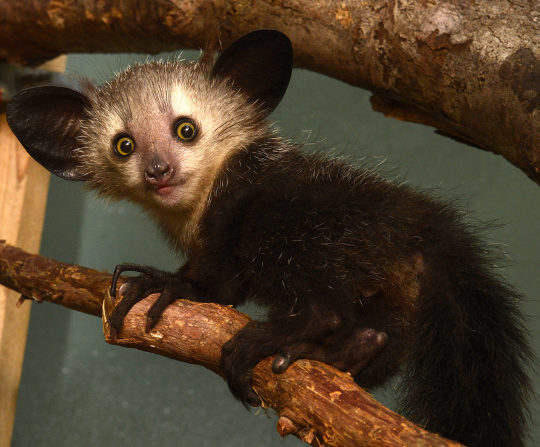
Indonesia
In this chapter, they travel to the island of Komodo to look at the Komodo dragons. Komodo dragons, thankfully, are still alive, but still endangered due to the fragility of their habitat. They're at risk of volcanoes, earthquakes, habitat loss, fire, tourism, loss of prey from poaching, and illegal poachnig in general. Climate chane and sea level rise also threaten their habitat. There are 1,380 mature individuals left in the wild and 3,400 total.

Democratic Republic of Congo (Zaïre at the time of the book's publishing)
In this chapter, they end up seeing two animals. They traveled to the country to see the northern white rhinocerous, but also ended up seeing mountain gorillas too because, as Adams says, "It is very hard to go all the way to Zaïre and not see them." Mountain gorillas, although listed as endangered, are still around. The World Wildlife Fund lists their population as just over 1,000 individuals. The specific area that Adams and Carwardine visit in the book, Virunga National Park, has seen an increase in population. When they visited in the late 80s, there was a population of 320, but as of 2010 there were 480.

Here's where my post actually gets sad. The animal that Adams and Carwardine actually planned to visit in the DRC was the northern white rhinocerous. In 1988 at the time of the trip (or perhaps 1990 at the publishing of the book), there were 22 individuals left in the wild, all in Garamba National Park. Twenty two. Douglas Adams writes about the sad state of their population, and compares it to the success of the subspecies the southern white rhino. He ends that section of the book with the sentence: "The point is, we are not too late to save the northern white rhinocerous from exctinction."
Feeling very energized after reading this, I had set down my book and pulled out my smartphone to google the northern white rhinocerous. The bad news is, the northern white rhino is functionally extinct in 2023. There are only two left in the entire world, and both are female, mother and daughter. Garamba National Park has suffered years of turmoil from politcal unrest, wars, insurgents, and poachers. In 2008, there were no northern white rhinos left in the wild and only 8 left in captivity.

There's some tentatively good news. Before the last male died in 2018, his sperm was collected. The remaining two living females cannot carry babies anymore, but the daughter's eggs were gathered. There's a team of scientists trying IVF, and since 2019 they've managed to get 24 embryos from one female and two males. They're planning on using another southern white rhino as a surrogate. Will this save the species? Who knows. Any babies that result will have to be inbred--either siblings or half-siblings. No genetic diversity remains in the subspecies. But it is interesting to me since this sort of thing used to not be possible at all for endangered species.
New Zealand
The first birds mentioned in this chapter is the Kea, which is also endangered, but this chapter isn't really about them. It's about the Kakapo. The Kakapo are probably my favorite animal described in this book, because they seem so silly. It's a wonder they never managed to go extinct at any point in history. I love them. Fortunately, there's good news for Kakapo: they're doing better!
Actually, I saw a tweet about them literally earlier today:
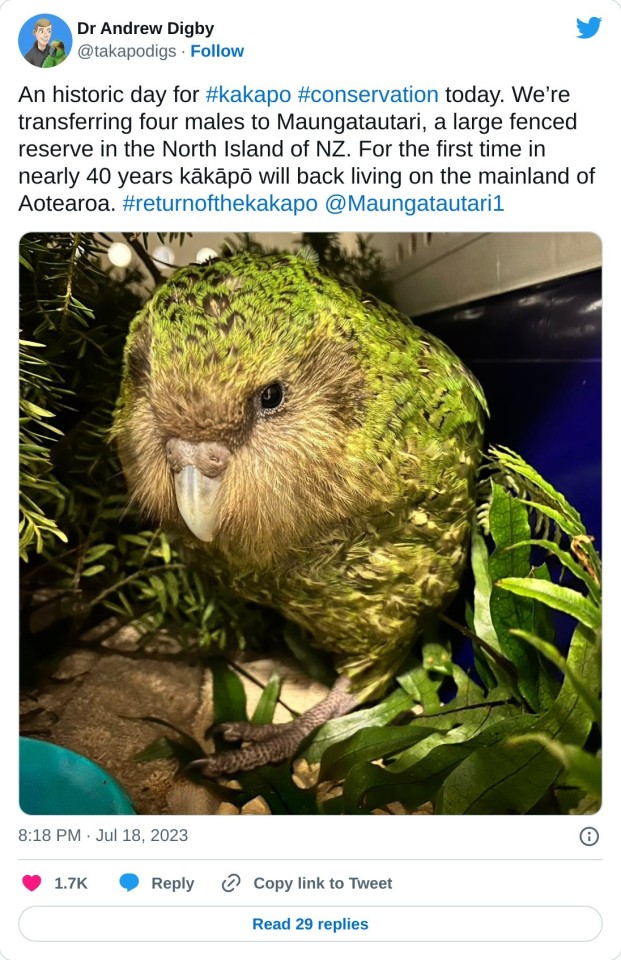
They're still considered critically endangered, but this is good news. As of 2023 there are 248, which is a significant increase in the ~70 that existed when the book was written. Yay, kākāpō! They're very cute.
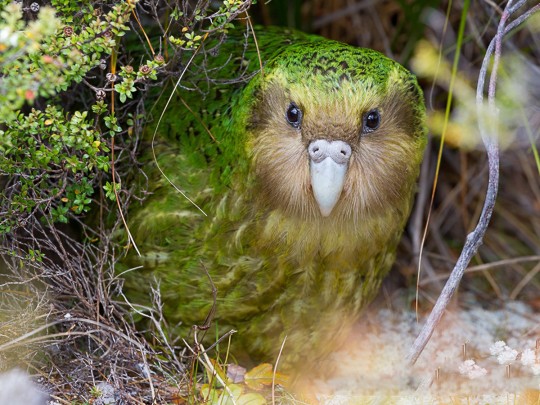
China
Here is where the post gets sad again. In this chapter, Adams and Carwardine visit the Yangtze in search of the baiji river dolphin. It has been 21 years since the last confirmed sighting of the baiji, and 17 years since they were considered extinct after no trace of them could be found. I find this particularly sad, because part of the chapter in this book has Adams and Carwardine visiting with the Tongling Baiji Conservation Committee, and their construction of a nature reserve on the river. The end of the chapter seems hopeful based on this hard work, so I also feel quite sad for all these people in 1989 who cared so much and were still unable to save these animals :(

Mauritius
This is the final chapter of the book, and covers quite a few animals. The original intention was for them to be looking for the Rodrigues fruit bat. These bats are endangered, but with increasing population. By the time of the book's publishing in 1990, the population had just passed the 1,000 mark. The Philadelphia Zoo website says with breeding programs, there are now 20,000 left in the wild.

Another species mentioned is the Mauritius Kestrel. In 1974, there were only 4 individuals left. Now, thanks to breeding programs, there are about 400 left in the wild as of 10 years ago. That's amazing, but it is a bit worrying still--in 2005, there were 800 in the wild. So there was a wildly successful reintroduction and now the population is dipping again. But if they survived it once, I think we can help them survive it again.
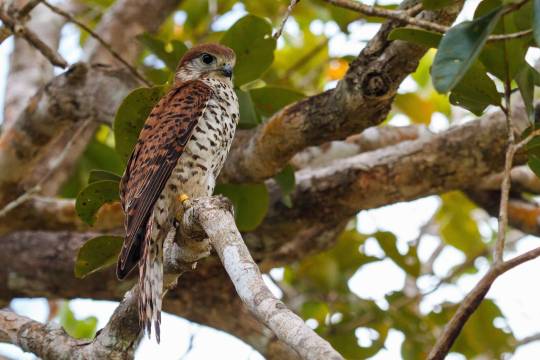
Another bird mentioned is the pink pigeon. As of the publishing of the book in 1990, there were less than 10 in the wild. Now, thanks to conservation efforts, there are approximately 480. They've suffered some loss of genetic diversity, though.
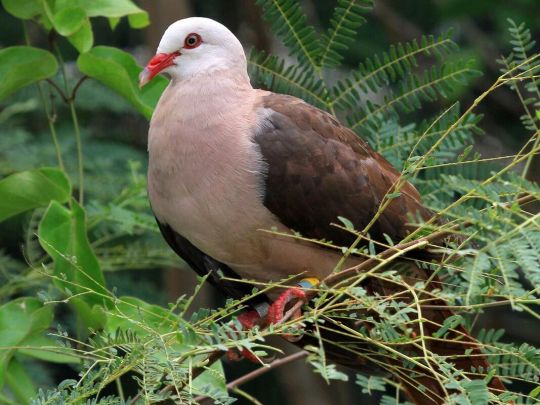
Finally, the echo parakeet is mentioned. As of the time of the book's publishing, there were less than 15 remaining in the wild. I am happy to say that as of 2020 there are more than 800 birds left in the wild, and their status has been moved from endangered to just vulnerable--a step up!

That brings me to the end of my tumblr book report. I was actually mildly surprised and happy to see that only two of the species mentioned in the book are extinct/functionally extinct, and that the others were saved from the brink. I seriously thought while googling some of the birds at the end that they would be gone, but fortunately they're still around.
Goodnight! I spent way too long writing this!
#i'm becoming a book blog now#long post#quara talks books#maybe talking about what i read will like. make me read more#i'm off to a good start this year but overall the amount of books i have Actually read recently is still depressingly low#im gonna change that though i promise
12 notes
·
View notes
Text
Why Hunting Is Good For the Enviroment
disclaimer, this is from a primarily new zealand perspective
goats destroy many native plants. when they eat a plant they usually kill it. wild mammals are extremely threatening to endangered species such as kakabeak, of which only 153 are left in the wild as of current. hunters massively contributed to eradicating these invasive species from mount Taranaki. this means native birds can be reintroduced, such as kiwi, blue ducks/whio, and kōkako, the latter of which may introduce themselves if there are few predators.
the plants often killed by goats, deer and pigs are also home to many lizard species, some of which are only found in Taranaki. a lot of people dont know, but these mammals (particularly deer, which need extra calcium for their antlers, and pigs, which are omnivores not herbivores) eat baby birds if given the chance. Aotearoa's native birds evolved with very few predators, and many nest near the ground where they are easily picked off.
and then theres the possums.
possums may be cute but they are a huge threat to Aotearoa's entire ecosystem. possums eat leaves of native plants and continue eating the new growth, stopping the plant from recovering. they can destroy entire canopies, resulting in forests being turned into low-lying bush. possums are a huge factor in the decline of plant species such as pōhutukawa, rātā and kōhekōhe. they eat eggs, chicks and even adults of kākā, kea, kiwi, kōkako, kererū, tui, fantails, bellbirds and more. every native species of Aotearoa is threatened by possums.
but there is something that can help. areas where possums are controlled have a significantly higher rate of success in nesting birds. hunters can shoot possums and can even sell the skin. possum fur is hollow to trap heat inside the hairs. it is very soft and warm and can be used for boots, coats, blankets, hats, and pretty much anything like that. the leather is soft and flexible but still tough.
around 2-3 decades ago, Aotearoa had approximately 50-70 MILLION possums. now research suggests there is around 30 million possums. compare that to the mere 5.5 million humans here. thats still a lot, but it is a huge improvement.
if it werent for hunters, there would still be goats, pigs and deer destroying the unique enviroment of mount Taranaki. next we need to eradicate possums. a single possum can eat up to 60 endangered carnivorous snails in a single night. we need to protect our native ecosystem. we cant let extreme anthropomorphzation (thinking animals are people) stop us from helping wildlife recover. if we dont do something, species will go extinct. human intervention saved the takahē. it can save more if we do it right. dont let more species die like the huia.
if the forest thrives, the birds thrive. if the birds thrive, the forest thrives.
#aotearoa#new zealand#hunting#possums#marsupial#birds#native species#conservation#animals#ecosystem#biodiversity#anarchism#anarchy#anarchocommunism#eco anarchy#eco anarchism#goat#deer
6 notes
·
View notes
Text
Life as an Environmental Interpreter
Hello friends,
Welcome back to another week of blogging!
To begin, when I first heard the term “nature interpreter,” I honestly didn’t really know what it meant, who it classified or why a nature interpreter would be an important role within the environmental world. I initially thought to myself, “nature doesn’t speak… so why would it need an interpreter?” However, as I sat here and pondered, I realized that nature does indeed speak to us in ways that are both subtle and direct and it’s up to us as receivers to cultivate awareness and choose to use our senses to listen. I’ve learned that nature interpreters are important because they allow us to understand the natural world and help us to use our senses to better connect and listen to the many forms of communication nature has to offer.
In my ideal world, I would love to have a job as an environmental interpreter at a local park where I would lead immersive and captivating tours through various different trails. I would love to have this role as an interpreter because hiking through trails is where I fell in love with the outdoors and where I found the most personal connection to nature. My tours would allow adults and children to connect with the biological and cultural diversity within the trails and lead everyone on a path of self-discovery and personal connection. As someone who is also very interested in history, my tours would go beyond simply the nature that is present and teach the group about the history of the trails, how the various organisms and wildlife evolved and where things are expected to evolve to in the future to add my own personal touch.



Here are some cool photos from a tour in the beautiful New Zealand!!!
In order to adapt to the needs of others in my role as an interpreter, I would need to implement a variety of different learning styles into my teaching approach while on the tours as well as pay attention to my specific audience at hand in order to adapt to their needs. For example, I can focus my attention more on sounds and noises such as bird species chirping on the tours for an audience who possess more auditory strengths. Oppositely, I can focus on elaborating more on the visual aspect of the tours such as the animal tracks on the ground, the variety of different insects or any other notable features to aid with my visual learners. In my advantage however, I am a tactile learner so I can use my tactile skills to use a more engaging and interactive approach to my tours by allowing the group to get their hands dirty and do more than simply walk and listen! I believe that no matter what style of learning works best for a person, the only way to truly experience the most out of nature is to use all senses to touch, smell, feel and see the beauty the world around us has to offer.
To conclude, I believe my main goal as an environmental interpreter is to have the visitors who follow along my tour leave the tour feeling different than they were before. Whether they feel more connected to themselves, more connected to nature, a heightened sense of creativity or appreciation or overall simply happier, I want my tours to leave a lasting impression on people! To me, the ability to teach and share my knowledge with others about a topic I am passionate about would be the most rewarding job and maybe in the future this will become a reality!
Thanks for listening :)
Natalie
3 notes
·
View notes
Text
Journeying Green: Discovering Eco-Friendly Travel Destinations
Embark on a journey to eco-friendly travel destinations and immerse yourself in sustainable adventures that leave a positive impact on the environment. Discover pristine natural landscapes, eco-conscious accommodations, and activities that promote conservation efforts. Here are some top eco-friendly travel destinations to consider:
Costa Rica: Known for its rich biodiversity and commitment to conservation, Costa Rica offers eco-lodges nestled within lush rainforests, opportunities for wildlife encounters, and sustainable tourism practices that prioritize environmental protection.
Norway: With its stunning fjords, expansive wilderness areas, and focus on renewable energy, Norway is a paradise for eco-conscious travelers. Experience sustainable activities like hiking, kayaking, and wildlife watching while supporting eco-friendly initiatives.
New Zealand: From its breathtaking national parks to eco-friendly lodges and sustainable tourism initiatives, New Zealand is a haven for nature lovers. Explore pristine beaches, volcanic landscapes, and protected wildlife habitats while minimizing your carbon footprint.
Bhutan: This small Himalayan kingdom is renowned for its commitment to Gross National Happiness (GNH) and sustainable development. Discover Bhutan's serene monasteries, scenic landscapes, and cultural heritage while contributing to responsible tourism practices.
3 notes
·
View notes
Text

#nature#forest#new zealand#new zeland landscape#travel#camping#nature asthetic#wilderness#green#hiking#vintage#wildlife#cabin#cabin in the woods#river#cottagecore#national park#photography
5 notes
·
View notes
Text

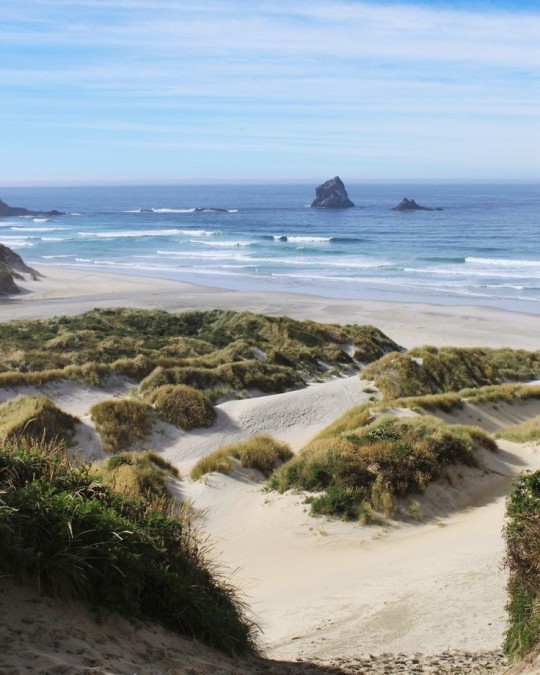


The Enchanting beauty of New Zealand
Nestled in the southwestern Pacific Ocean, New Zealand beckons travelers with its unparalleled natural beauty, diverse landscapes, and rich cultural heritage. A land of towering mountains, pristine beaches, lush forests, and vibrant cities, New Zealand offers a myriad of experiences waiting to be explored.
From the snow-capped peaks of the Southern Alps to the rugged fjords of Fiordland National Park, New Zealand's landscapes are nothing short of breathtaking. The North Island boasts geothermal wonders like Rotorua's bubbling mud pools and geysers, while the South Island is home to the majestic Milford Sound, where cascading waterfalls tumble down sheer cliffs into pristine waters. With its abundance of hiking trails, scenic drives, and adventure activities, New Zealand is a playground for outdoor enthusiasts and nature lovers alike.
The indigenous Maori culture infuses New Zealand with a sense of authenticity and reverence for the land. Visitors can immerse themselves in Maori traditions through cultural performances, traditional feasts (hangi), and visits to marae (Maori meeting grounds). Places like Te Papa Tongarewa, the national museum of New Zealand, offer insights into Maori history, art, and spirituality, while cultural tours provide opportunities to engage with local communities and learn about their customs and beliefs.
Despite its reputation as a haven for outdoor adventure, New Zealand's cities are vibrant hubs of culture, cuisine, and creativity. Auckland, the "City of Sails," boasts a stunning waterfront, bustling markets, and a diverse culinary scene influenced by its multicultural population. Wellington, the capital city, is a haven for arts and culture, with its thriving music, film, and culinary scenes. Meanwhile, Christchurch, with its revitalized post-earthquake landscape, offers a blend of heritage architecture, innovative urban design, and green spaces.
New Zealand is committed to sustainable tourism practices, striving to protect its natural environment and cultural heritage for future generations. From eco-friendly accommodations to conservation initiatives aimed at preserving native wildlife and ecosystems, the country prioritizes responsible tourism that respects and honors the land and its people.
New Zealand, with its awe-inspiring landscapes, rich cultural tapestry, and commitment to sustainability, invites travelers on a journey of exploration and discovery. Whether traversing rugged mountains, immersing in Maori culture, or savoring culinary delights in vibrant cities, Aotearoa promises an unforgettable experience that lingers in the hearts and memories of all who visit. So, pack your bags and embark on an adventure to New Zealand, where every moment is filled with wonder and possibility.
3 notes
·
View notes
Text
SYDNEY: More than 50 pilot whales have died hours after stranding themselves on a beach in Western Australia, with authorities saying on Wednesday (Jul 26) they are scrambling to save dozens more.
A pod of almost 100 long-finned pilot whales was spotted off Cheynes Beach near Albany, about 400km southeast of Perth on Tuesday evening.
Experts from the state's Parks and Wildlife Service were joined by volunteers, who worked through the night, braving cold temperatures to monitor the whales.
The service confirmed on Wednesday morning that 51 of the animals had died.
The organisation said it is now working with volunteers to try and save the remaining 46 whales, with plans to guide them to deeper water during the course of the day.
Footage from the scene showed volunteers, many of them wearing wetsuits, working busily to help the thrashing mammals on the shores of the beach.
A spokesperson for the Parks and Wildlife Service said it had been "overwhelmed with hundreds of offers of help" but that it had enough volunteers and the public should "stay away" from the beach "for safety reasons".
"The priority focus of the Incident Management Team is to ensure the safety of staff and volunteers and the welfare of the whales," they said.
"The response zone has a range of hazards, including large, distressed and potentially sick whales, sharks, waves, heavy machinery and vessels."
Mass strandings of pilot whales are not uncommon in Australia and New Zealand.
Last October, around 500 pilot whales died when they beached on the remote Chatham Islands in New Zealand.
Scientists do not fully understand why mass strandings occur, but pilot whales - which can grow to more than 6m long - are highly sociable, so they may follow pod-mates who stray into danger.
Bec Wellard, a marine mammal scientist at Project Orca, said the reasons for whale strandings were still not known for sure.
She told AFP: "We still don't know why - if we did, we could perhaps do more to prevent it.
"But with pilot whales, they frequently strand en masse - an individual might be ill or in trouble and the rest of the pod follows them - that can lead them to strand."
She said that because of the pilot whales' "strong family bonds", it was important to try to re-float them together.
But she added that, if the surviving whales' health is compromised, an assessment needs to be made as to whether efforts to refloat them "could just be prolonging their suffering".
8 notes
·
View notes
Text
Discovering Bliss: Unveiling the Best Family Trip Destinations for Unforgettable Memories

Introduction:
Planning the perfect family trip involves finding a destination that caters to everyone's interests, creating a harmonious blend of adventure, relaxation, and bonding. Whether your family craves cultural experiences, outdoor adventures, or simply some quality time together, the world is full of enchanting places waiting to be explored. Here's a curated list of some of the best family trip destinations, each promising a unique and memorable experience for every member of your clan.
Orlando, Florida - The Theme Park Capital: Nestled in the heart of Florida, Orlando stands tall as the ultimate haven for families seeking magical moments. Home to Walt Disney World Resort, Universal Studios, and SeaWorld, Orlando promises an immersive adventure for both the young and the young at heart. From thrilling rides to character encounters, this vibrant city is a surefire way to spark joy in every family member.
Queenstown, New Zealand - Adventure Playground: If your family leans towards the adventurous side, Queenstown in New Zealand is a dream destination. Surrounded by the stunning Southern Alps and nestled on the shores of Lake Wakatipu, Queenstown offers a plethora of outdoor activities. From bungee jumping and jet boating to hiking and skiing, this adrenaline-packed paradise ensures an exhilarating experience for every family member.
Barcelona, Spain - A Tapestry of Culture: For families with a penchant for culture, Barcelona is an artful masterpiece waiting to be explored. Marvel at the surreal architecture of Antoni Gaudí, wander through the historic Gothic Quarter, and soak in the vibrant atmosphere of La Rambla. Barcelona seamlessly blends history, art, and delicious cuisine, making it an ideal destination for families eager to immerse themselves in a rich cultural tapestry.
Yellowstone National Park, USA - Nature's Wonderland: Nature-loving families will find solace and wonder in the breathtaking landscapes of Yellowstone National Park. From the iconic Old Faithful geyser to the mesmerizing Grand Prismatic Spring, Yellowstone is a natural playground filled with wildlife, hiking trails, and geothermal wonders. Camping under the starry skies or observing bison grazing in their natural habitat creates a serene backdrop for family bonding.
Kyoto, Japan - Tranquility Amidst Tradition: Kyoto, with its serene temples, traditional tea houses, and breathtaking gardens, provides a serene escape for families seeking tranquility. Explore the historic Fushimi Inari Shrine, participate in a tea ceremony, and stroll through the mesmerizing Arashiyama Bamboo Grove. Kyoto offers a perfect blend of cultural immersion and relaxation, creating an ideal family trip destination for those who value peace and connection.
Conclusion:
Selecting the best family trip destination involves considering the unique interests and dynamics of your loved ones. Whether you're seeking adventure, cultural exploration, or simply a tranquil retreat, these destinations provide a diverse range of experiences to create lasting memories. So, embark on a journey of discovery, laughter, and togetherness, as these handpicked destinations promise to be the backdrop for an unforgettable family adventure.
#family travel ideas#best family trip destinations#best family vacation itinerary#family vacation itineraries#vacation destinations for families
2 notes
·
View notes
Text
Court Circular | 17th February 2023
Buckingham Palace
General Sir Patrick Sanders (Chief of the General Staff) was received by The King this morning.
The President of the Republic of Poland visited His Majesty today.
The King this afternoon held a Reception at Buckingham Palace in support of Global Biodiversity.
By command of His Majesty, Mr Alistair Harrison (Marshal of the Diplomatic Corps) called upon His Excellency Mr Ioannis Raptakis at 1A Holland Park, London W11, this morning in order to bid farewell to His Excellency upon relinquishing his appointment as Ambassador from the Hellenic Republic to the Court of St James’s.
St James’s Palace
The Princess Royal, accompanied by Vice Admiral Sir Tim Laurence, today carried out the following engagements in Christchurch, New Zealand.
Her Royal Highness this morning attended a briefing on the rebuilding of Christchurch Central City and Christ Church Cathedral at Turanga Library, Christchurch, and visited the site of Christ Church Cathedral in Cathedral Square.
The Princess Royal today attended the Rededication Service for the Citizens’ War Memorial and laid a wreath in Cathedral Square.
Her Royal Highness, President, Royal Agricultural Society of the Commonwealth, this afternoon visited the Royal Agricultural Society of New Zealand and Canterbury Agricultural and Pastoral Association at Canterbury Agricultural Park, 102 Curletts Road, Hillmorton.
The Princess Royal, President, Royal Agricultural Society of the Commonwealth, later visited Untouched World Merino and Natural Fibre Workrooms, 155 Roydvale Avenue.
Her Royal Highness, Patron, the New Zealand Conservation Trust, afterwards visited Willowbank Wildlife Reserve, 60 Hussey Road, Northwood.
Kensington Palace
The Duke of Gloucester, Patron, Nuffield Farming Scholarships Trust, this morning received Mr Christoph Graf Grote upon relinquishing his appointment as Chairman and Mr Wyn Owen upon assuming the appointment.
His Royal Highness, Patron, Canine Partners for Independence, this afternoon received Mr Clive Elwood (Chairman of Trustees) and Mr Alexandre Lochrane (Chief Executive Officer).
#court circular#princess anne#princess royal#tim laurence#king charles iii#duke of gloucester#british royal family
12 notes
·
View notes
Text
Peel Forest Accommodation: A Perfect Place to Relax and Rejuvenate

Nestled amidst the breathtaking Southern Alps in New Zealand, Peel Forest Accommodation is a hidden gem that offers an idyllic escape from the hustle and bustle of city life. Here, you can immerse yourself in nature's beauty while enjoying a range of outdoor activities or simply relaxing in comfortable accommodations surrounded by serene forests. Whether you're seeking adventure or looking to unwind, Peel Forest Accommodation is the perfect destination for rejuvenation and relaxation. Join us as we explore this enchanting retreat and discover why it should be on your travel bucket list!
Peel Forest Accommodation is a secluded retreat located in the heart of Canterbury's stunning Peel Forest Park. It offers guests a variety of accommodation options ranging from comfortable lodge rooms to private cottages and luxurious glamping tents.
The accommodations at Peel Forest are known for their rustic charm and modern amenities, providing guests with everything they need for a comfortable stay. Some of the lodges even feature wood-burning fireplaces, perfect for cosying up on chilly nights.
One of the main draws of Peel Forest Accommodation is its proximity to nature. The park boasts an incredible landscape featuring towering trees, pristine rivers, and awe-inspiring mountains that provide endless opportunities for outdoor adventures including hiking, fishing, horseback riding, mountain biking and more.
In addition to its natural beauty and outdoor activities, Peel Forest also offers various facilities such as BBQ areas ideal for family gatherings or group events. Overall it's an idyllic destination that provides visitors with peace & tranquillity away from busy city life.
Peel Forest Accommodation offers a wide range of facilities that cater to the needs of every guest. The rooms are equipped with everything you need for a comfortable stay, including quality bedding, towels, and toiletries. Each room also has its own private bathroom.
If you're travelling with family or friends, the shared living spaces in Peel Forest Accommodation are perfect for socializing and relaxing. You can enjoy a game night in the lounge area or cook up a feast in the fully-equipped communal kitchen.
The outdoor areas at Peel Forest Accommodation are equally impressive. There's plenty of space to soak up some sun on the deck or sit around the fire pit under starry skies at night. If you want to explore nature trails nearby, bikes and kayaks are available for rent.
For those who prefer indoor activities, there's also an entertainment room complete with table tennis and board games. Additionally, free Wi-Fi is available throughout the property so guests can stay connected during their stay.
Peel Forest Accommodation provides exceptional facilities that make it easy to relax and unwind during your holiday experience in New Zealand’s South Island region.
Peel Forest Accommodation offers a range of outdoor activities that are perfect for those who love to explore nature and indulge in thrilling adventures. With its location near the Southern Alps, there is no shortage of exciting things to do.
One of the most popular activities at Peel Forest Accommodation is hiking. There are plenty of walking trails available that cater to all levels of fitness and experience. Whether you're looking for a leisurely stroll or a challenging hike up the mountains, there's something for everyone.
For those who enjoy water sports, kayaking and rafting on the nearby rivers are also available options. The Rangitata River in particular is known for its rapids and attracts adrenaline junkies from all over.
If you prefer something more laid back, fishing in one of the many streams or lakes around Peel Forest can be a great way to spend your day. You might even get lucky enough to catch some trout!
Animal lovers will appreciate the wildlife-spotting opportunities at Peel Forest Accommodation. Keep an eye out for native species like kea parrots, tui birds, and New Zealand fur seals as you explore this beautiful region.
With so many outdoor activities available at Peel Forest Accommodation, visitors can truly reconnect with nature while enjoying their stay in comfort and style!Peel Forest Accommodation is an absolute gem for those who want to escape the hustle and bustle of city life. It offers a tranquil environment where you can unwind, relax and rejuvenate your mind, body and soul.
The facilities at Peel Forest Accommodation are second to none, with its comfortable rooms, cosy lounge areas, modern kitchens and outdoor BBQ area. Guests have access to all they need in order to make their stay as comfortable as possible.
5 notes
·
View notes